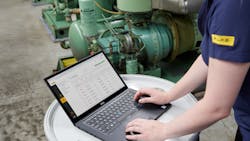Food safety and quality management with maintenance software and sensors
The food and beverage processing industry must contend with many layers of complexity. Downtime is expensive, and food safety and quality management are key to keeping customers healthy and safe. And regulatory compliance issues and audits can be time consuming. Keeping up with all these processes, and the documentation and data associated with them, requires an effective maintenance management system as well as real-time insights into operating conditions.
With the rise of cloud-based software, food and beverage processors have increasingly accomplished this using computerized maintenance management system (CMMS) software, which not only provides work management, but can also centralize and aggregate data from multiple sources. Through integrations with software across the enterprise, like Supervisory Control and Data Acquisition (SCADA) or Enterprise Resource Planning (ERP) systems, plus connections to condition monitoring sensors, modern maintenance software is changing what is possible for maintenance teams.
Performing maintenance based on asset condition can increase the effectiveness and efficiency of a maintenance program. For example, with condition monitoring sensor data flowing in, an analysis software identifies a problem, and a CMMS can aggregate condition monitoring alerts. Maintenance teams can then respond promptly when and where they are needed most. Data-driven maintenance decisions can reduce unplanned downtime and overall maintenance costs. And when paired with machine-mounted sensors, today’s software solutions can mitigate recall risk, streamline the compliance process and maximize asset uptime.
In addition to maintaining equipment, food and beverage processors must monitor the safety and nutritional qualities of their products. They must follow proper handling and storage requirements for both ingredients and finished products. And, to prevent waste, effective inventory management is crucial. Standardized processes and workflows ensure the safety of the foods and beverages produced — as well as the safety of the workers during production.
Integrating software with sensors unlocks new possibilities. Many food and beverage processing facilities use SCADA systems to monitor their production lines in real time. A CMMS can gather the SCADA data and — combined with automatically generated condition monitoring alarms — help teams respond quickly and make informed decisions on equipment repairs. Integrating multiple data sources facilitates faster and better maintenance decisions and maximizes the use of maintenance resources. Considering the staffing limitations many organizations face today, the ability to use sensors to monitor assets remotely is beneficial.
Sensor applications in food and beverage processing
Sensors have a wide range of applications in food and beverage processing, whether they are used to monitor products or equipment. Sensors can be used to detect and identify contaminants, and evaluate freshness and other aspects of quality control. To be useful in a food and beverage facility, sensors must be durable, sensitive and accurate.
Mounted on machinery, sensors can monitor equipment for specific attributes, such as vibration or temperature. If an asset’s temperature or vibration pattern changes or falls outside of established norms, a sensor connected to cloud-based software can instantly send an alert. With real-time knowledge of machine health, teams can respond right away and prevent costly unplanned downtime.
Condition-based maintenance is a strategy that determines maintenance actions based on machine condition in real time, rather than taking arbitrary action based on a calendar. This strategy reduces waste and risk, while making prioritization easier.
When analysis software alerts maintenance teams to what is wrong, teams can determine how to best use their resources — from parts to labor hours to scheduling. Planned downtime is a precious commodity in the food and beverage processing industry, so maintenance actions must be planned and prioritized for maximum effectiveness.
The advancements of cloud-based software and affordable sensors have made real-time monitoring a scalable and feasible solution for food and beverage processing. The products and the equipment used to produce them can be covered by a combination of software and sensors to a degree that was not previously feasible.
The benefits of cloud-based software
There are many benefits to using a cloud-based CMMS. For example, it can simplify food safety and regulatory compliance. Capturing e-signatures, details about inspection failures and proof of meeting post-maintenance sanitation and quality standards are just a few benefits of using a cloud-based CMMS. And digitized records and audit dashboards make it easy to demonstrate compliance.
Using analysis software, teams can take the data that sensors have collected and generate not just insights and recommendations, but work orders. The ability to manage multiple processes from one place makes running a complex operation simpler and ensures everyone has the same set of facts.
Software and sensors in practice
In food and beverage processing, as in many other industries, maximizing uptime means maximizing revenue. But food and beverage processors have maintenance requirements distinct from other industries.
The food and beverage industry has some unique asset needs. For example, ammonia is commonly used for cold storage, with ammonia refrigeration systems relying on compressors that pressurize ammonia gas. In addition, many types of equipment are connected by conveyors, belts and fasteners. Maintaining each of these components so that the production line keeps moving requires time and attention. Installing condition monitoring sensors connected to CMMS is a proven way to reduce downtime and increase safety.
What does it look like in practice when a food and beverage manufacturer implements CMMS software together with sensors?
Promoting food safety records
Snack foods manufacturer Monogram Foods has never had a recall despite producing large volumes. One plant alone makes 1.7 million corn dogs and mini corn dogs daily.
With more than 3,000 assets and 5,000 employees across nine plant locations, Monogram Foods sought a centralized CMMS to help standardize maintenance and manage its assets, which include boilers, compressors, packaging machines, slicers and more.
The company valued its food safety record and sought to enable maintenance and reliability teams to make data-driven decisions by gaining a more comprehensive picture of plant activities.
Implementing a modern CMMS let Monogram Foods establish asset performance baselines. This data helps identify poor performance trends so teams can discover root causes early. Monogram also began streamlining processes, refining workflows, automating parts reordering and standardizing PMs.
After implementing a CMMS, Monogram Foods began using vibration sensors to monitor the condition of a critical piece of equipment — a new compressor — around the clock. Data from the sensors is routed to the company’s cloud-based CMMS. This gives teams real-time performance data from anywhere using smart devices.
Staving off unplanned downtime
The Jack Daniel Cooperage in Trinity, Alabama, makes thousands of barrels per week for Jack Daniel’s and other brands within Brown-Forman. The facility uses two types of vibration sensors with its CMMS. By connecting those sensors with their CMMS, the Jack Daniel Cooperage team can automatically generate work orders anytime equipment exceeds set temperature and vibration thresholds. The sensors and software work together to update the maintenance team on how equipment is operating.
Every technician on the Jack Daniel Cooperage maintenance team uses the CMMS.
The work order system helps them plan and prioritize their work. Identifying what is most urgent or what will require specialized parts or labor ensures that the team has the right resources when and where they need them.
Woodworking means dust, so in addition to the equipment used to make the barrels themselves, the cooperage has a robust dust collection system. It uses vibration sensors on the gearboxes, blowers, bearings and motors that make up the dust collection system. If that system goes down, the entire operation shuts down.
With access to real-time asset condition data, the cooperage can plan rather than just react. By focusing on continuous improvement and connected reliability, the cooperage has experienced so much success that its strategies are being rolled out at facilities throughout Brown-Forman.
Connected reliability
The food and beverage processing industry is highly regulated for good reason. With the end products made for human consumption, deviations from strict processes can lead to outbreaks of illness. Recalls and lawsuits are costly as well. Food and beverage processors need all of the tools at their disposal to balance their priorities: product excellence, operational efficiency and achieving compliance standards, to name a few.
Having access to all the data and answers that sensors provide in one centralized maintenance management system gives teams the perspective they need in their operations. This combination of software and sensors — called connected reliability — has changed what is possible. Condition monitoring uses IIoT sensors to monitor assets in real time, sending data to a CMMS. The CMMS can analyze the data to spot aberrations and automatically notify teams of potential faults.
As a result, maintenance teams are able to focus their energy on the most important problems. Having real-time asset condition data not only helps prevent unplanned downtime, it eliminates the risk and expense involved in needlessly servicing equipment.
Data-driven decisions, improved recordkeeping and standardized processes have made it easier for teams to meet strict standards on tight budgets and still achieve their organizational goals. The benefits of condition-based maintenance can be achieved by pairing sensors and software effectively.
As a mechanical application and product specialist with Fluke Reliability, John Bernet works with customers from all industries to successfully implement their reliability programs.
Fluke Reliability
About the Author
John Bernet
Mechanical application and product specialist with Fluke Reliability
As a mechanical application and product specialist with Fluke Reliability, John Bernet works with customers from all industries to successfully implement their reliability programs. He has more than 30 years of experience in the maintenance and operation of commercial machinery and as a nuclear power plant electrician in the U.S. Navy. He holds a Category II Vibration Analyst certification and is a Certified Maintenance Reliability Professional (CMRP).

